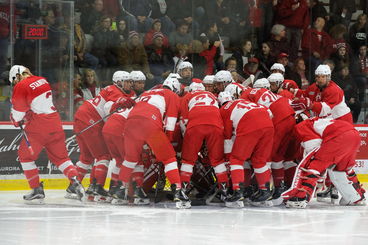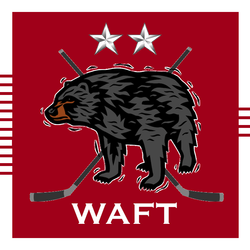Coach Schafer and this team decided to give a more manifest depiction of what it means to reset the culture of Cornell hockey and return the programs to its roots. The coach's and team's daring idea would drag a time-honored tradition of Schafer from the locker room onto the ice of competition. Each player would wear his personal answer to Schafer's seasonal inquiry of the best player to have worn each number for the carnelian and white in the place of his own name.
Icers for the Big Red not too infrequently wear the names of famous wearers of their numbers. Usually, as during the 2010-11 season, fans vote to select which player was the best player from any era to have worn each number. The process was somewhat different in the 2004-05 season when the players on the team voted to select the most deserving wearer of each number. The 2004-05 process is far more desirable than the one used in the 2010-11 season. Schafer and this team more than improved on either this season. They perfected it for generations to come.
Allowing each player individually, rather than the team collectively via a vote, to choose the name of the player whose career and legacy that each current player wants to honor personalizes the task of research and experience of wearing the name and number. This writer was somewhat suspicious when he learned that the sweaters onto which the twill of these legends would be sewn would not be of the iconic Cornell uniform.
These jerseys would be new. They would not be a throwback to a version from either the 1966-67 or 1969-70 season. To the surprise of some readers (after seeing the sweaters, I admittedly waited for that), this writer loved the idea. It was brazen. It did the truly unexpected. It was bold: In honoring tradition, it would buck it.
As if that was not enough to sate the intellectual curiosity of the Lynah Faithful and this observer, the official release that announced the honorific attire dared more. It is this stray, somewhat throw-away, sentence that inspires this piece.
The jerseys will be worn again later this season, and auction details will be finalized at a later date.
This writer will dare to venture a guess. Cornell auctioned its sweaters from the first Frozen Apple to benefit the Wounded Warrior Project. These history-demonstrating threads are conveniently of the rouge hue. This fact made them even more of a throwback at Lynah Rink (Red teams in the 1960s and early 1970s wore carnelian at home). It allows these uniforms to double as modern road sweaters. Cornell is the de jure road team at Red Hot Hockey V. Do not be too surprised if Brian Campbell, Brian Cornell, Ken Dryden, Dave Ferguson, Doug Ferguson, Brian Ferlin, Blake Gallagher, Colin Greening, Dan Lodboa, Gordie Lowe, Topher Scott, Ben Scrivens, Pete Shier, Skip Stanowski, and Pete Tufford take the ice of Manhattan another time for the Big Red on November 28.
This writer finds himself asking, why stop there? Why should these perfect sweaters in all that they symbolize be limited to a two-game stand? Why should they not start a tradition of their own?
There is no good reason to limit the use of these sweaters in this season or any future season (we will get to that later) to appearances in just two games. Objections that they are non-traditional to the Cornell hockey program grossly overstate the historic uniformity of Cornell's uniforms. Teams wearing a jersey other than Cornell's traditional jersey won two of the Red's 12 Whitelaw Cups (you know, the same or greater amount won by half of ECAC Hockey programs). Four members of those teams from 1980 and 1986, Jim Gibson, Steve Inglehart, Roy Kerling, and Joe Nieuwendyk, are honored with jerseys for auction. Attempting to argue that their careers do not add to the tradition of Cornell hockey because they wore a different jersey is a fool's errand. Having dispensed with the strongest point of opposition, why should they be worn again?
The aesthetic dimensions need addressing. The sweaters looked amazing. They were and represented everything that a Cornell hockey sweater should. The jerseys are devoid of garish frills. They utterly lack gaudiness. The emphasis is on the team and play, not the ostentation of a crest or loud palette. It reflects Cornell in both design and spirit.
Coach Schafer is attempting to reset the culture of Cornell hockey. Team unity and selflessness, or as it was described as early as 1911, having a "lack of the grand stand player," are hallmarks of all great Cornell hockey teams. Incorporating a third jersey of this kind every season into the future will ensure that a reset is not needed in the future.
Each season, players could re-evaluate which player they chose for the previous season. Auctioning off the sweaters for charitable causes at the end of each season reinforces this process. Players could elect to keep the same number and try to honor the same legacy, or bring awareness to another career. Newcomers would be thrown immediately into the rich lore of Cornell hockey when they were required to make this choice for the Red's alternate third jersey. The task of researching never again could fall by the wayside.
A lot can be learned about each current player from whose legacy he chooses to honor. That is one thing that this contributor might tweak if given the chance. Rather than making it an all-or-nothing approach of finding the best-ever player to wear the jersey which too easily lends itself to cursory glancing at statistics, the task should be modified to whose legacy does each player wish to resemble or channel with his career?
Consider two iconic numbers: #3 and #14. Lynah Faithful deserving of the name know the two people to whom those numbers "belong." Mike Schafer and Dan Lodboa, right?
Well, a lot can be gleaned about a wearer of #3 who chooses Skip Stanowski (as Reece Willcox does) or Steve Hennessy. None of those choices is wrong. The choice is revealing. No player other than perhaps Dryden owns his number more than Dan Lodboa owns #14. However, a #14 wearer can elect to honor the tradition in that numeral from Pete Natyshak or Riley Nash. Once again, all three enjoyed distinct and historic careers. Changing this lens and permanently incorporating these jerseys as a third jersey allow players to announce to the college-hockey world and the Lynah Faithful what they expect of themselves and what type of person and player they aim to be.
Coach Schafer is concerned with selflessness. Nothing instills selflessness like removing a player's name from the back of his jersey and replacing it with that of another who wore the uniform before him. It becomes apparent that player plays for someone greater. He plays for something greater. Tradition and expectations are unavoidable to the current wearer.
These sweaters this season should not be limited to two-time use. These sweaters should be used throughout this season when Coach Schafer or this team wants to send a message to themselves, their opponents, or their fans. They can and should be auctioned at the end of the season as expected for a worthy cause. It should wait until the end of the season.
If this team feels impelled to greatness in these third uniforms, should it be prevented from donning them in the playoffs?
These sweaters should not be limited to just this season. The same or similar alternates with the same message should be a new staple and emergent tradition for Cornell hockey. Could there be a greater statement of history, unity, and abnegation than seeing a team take the ice on college hockey's greatest stages electing to wear the names of greats who came before them rather than their own names?
This gesture would rival Brendan Morrison's speech after the 1996 Frozen Four Final. For those curious, it would be allowed. Rules 9.1 and 9.6 pertaining to regulation of player uniforms in the 2015-16 NCAA Ice Hockey Rules and Interpretations neither require the names of players to be displayed on jerseys nor prohibit placing the names of former players on a nameplate. In accordance with rules of the NCAA and the ethos of Cornell hockey, it seems foolish for Cornell's athletic department, the Cornell hockey program, Coach Schafer, this team, and succeeding teams not to champion this tradition or for fans of the program to resist it.
Boston College and Minnesota can keep their stars.
Cornell should be known for having in its stable an alternate third jersey that indelibly connects the present to the past, the individual to the team, and oneself to selflessness.




 RSS Feed
RSS Feed
